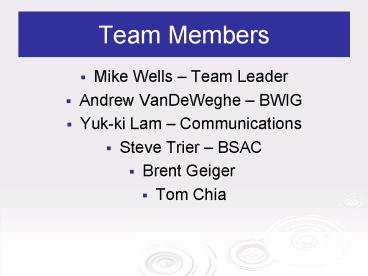Team Members - PowerPoint PPT Presentation
1 / 23
Title:
Team Members
Description:
... magnetic field at a radio-frequency causes the spin of some H atoms to re-align. Energy is released when these spins return to their normal state. ... – PowerPoint PPT presentation
Number of Views:35
Avg rating:3.0/5.0
Title: Team Members
1
Team Members
- Mike Wells Team Leader
- Andrew VanDeWeghe BWIG
- Yuk-ki Lam Communications
- Steve Trier BSAC
- Brent Geiger
- Tom Chia
2
Client
- Andrew Alexander Ph.D.
- Assistant Professor of Medical Physics and
Psychiatry - Keck Laboratory at the Waisman Center
Advisor
- Mitchell Tyler M.E., P.E.
3
Abstract
- A small movement during an MRI scan causes the
images to become blurred and gives unusable
results. The proposed optical motion sensor
device will serve as a head motion detector and
feedback mechanism for training patients to
suppress movement while in a mock MRI
environment. It is expected that this device
will reduce head motion during an actual MRI scan
and will produce better results in fewer scans.
Ultimately, this will save time, money, and most
importantly will reduce stress for the patient.
4
Problem Definition
- To design a device that
- detects head movement in an MRI simulator
- quantifies movement on a millimeter scale
- provides feedback
- does not change the simulator environment
- non-invasive to the patient (comfortable)
- easy to operate
5
Motivation
- Reduced head movement in the actual MRI will
- Produce better images in fewer scans
- Save time and money
- Relieve stress on the patient and client
- Only a bite bar is currently available to
restrict head motion (in the MRI simulator ) - Does not work for all patients
6
Background
- Magnetic Resonance Imaging (MRI) produces an
image by using strong magnetic fields - Spin orientations of H atoms align with the
applied field - Using a second magnetic field at a
radio-frequency causes the spin of some H atoms
to re-align - Energy is released when these spins return to
their normal state. - This energy is what is recorded and is used to
produce an image
7
The MRI Simulator
- Main purpose is to familiarize patients to the
enclosed environment of the MRI tube - Goggles and headphones provide visual images and
simulate the loud noise of the actual MRI machine - Especially important for training children,
elderly, claustrophobic, and exceptionally
nervous patients
8
Design Criteria
- Ergonomics
- Patient comfort, non-invasive, not dangerous,
cleaned easily, readily accessible - Simplicity and Adaptability
- Simple to operate, applicable to all patients, no
unnecessary complications - Feasibility
- Working prototype by the end of the semester,
must be within cost restraints
9
Design Criteria
- Sensitivity/Accuracy
- Must be able to measure movement of 1mm, must be
consistent - Price
- Final prototype must be less than 500, final
device must be affordable by Waisman labs
10
Proposed Designs
- Headband Photosensor
- Focused light source attached to headband worn by
patient - Photosensor mounted on head coil above light
source - Light/photosensor system measures head movement
and provides feedback response
11
Proposed Designs
- Strain Gauge System
- Force platform and strain gauges built into
pillow of MRI simulator - Strain gauge array measures head motion through
pressure changes and provides feedback response
12
Proposed Designs
- Optical Image Tracking
- Use basic optical mouse technology
- CMOS sensor, LED, Signal Processor
- Optical sensor mounted in position near patients
head - Processor analyzes changes in images (from CMOS
sensor) and translates pixel movement into head
motion data
13
Decision Matrix
14
Final Design
- Modified optical image tracking system
- Only one sensor (feasibility)
- Placed on patients forehead
- Forehead is ideal because it is broad, flat, free
of hair, and transfers all head motion - Computer analysis
- Based in LabView 6.1
- Variable error setting
- Feedback Light Sound
15
LabVIEW Interface
16
Prototype Design
- Wireless Mouse disassembled
- Separated into RF transmission board and optical
sensor board - Optical sensor mounted in small project box and
connected by wire to RF board mounted in larger
project box with on/off power switch - Mock setup of goggles constructed
- Adjustable, full scale
17
Prototype Design
- Optical sensor box mounted on goggles
- Allows vertical motion, rotation, LED is directed
away from patient - Interchangeable clear plastic strip between
sensor and patient - Patient comfort
- Sanitary needs
18
Testing
- Screen resolution set to 1024 x 768.
- Acceleration of mouse turned off.
- Speed of cursor set to fast for precision.
- Light contact with skin works best.
- 48 trials of varying distance were performed to
obtain a relationship between distance and cursor
movement.
19
Calibration
20
Ethical Considerations
- Eye exposure to LED
- Normal usage of AllnGaP II LED (639nm) poses NO
danger to eyes - Agilent Technologies
- On/Off switch minimizes LED exposure
- Sensor LED rays directed away from eyes
- Collision of sensor w/ patients head
- Mobile sensor mount moves in response to movement
21
Ethical Considerations
- Sanitation
- Comfortable, sterile, and disposable sensor
covers - Possible electrical shock or injury from contact
with device - Sharp objects and loose wires contained in
project boxes
22
Conclusion
- Final design fulfills restraints
- 1 mm resolution
- Notification of excessive movement
- Non-invasiveness
- Addressed safety issues
- LED exposure
- Sanitation
23
Future Work
- Eliminate contact with patient
- Improve LED light to softer color or infrared
- Improve quality of data interpretation
- New options auto-feedback, sampling rate, data
analysis































